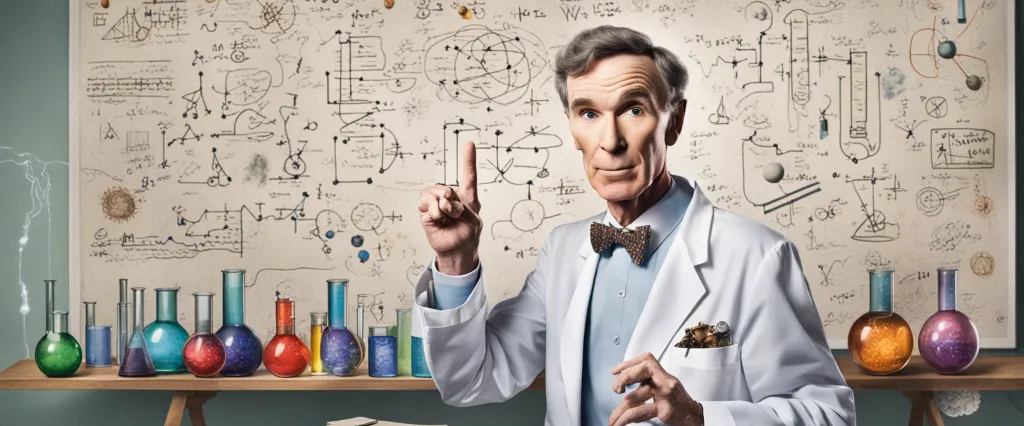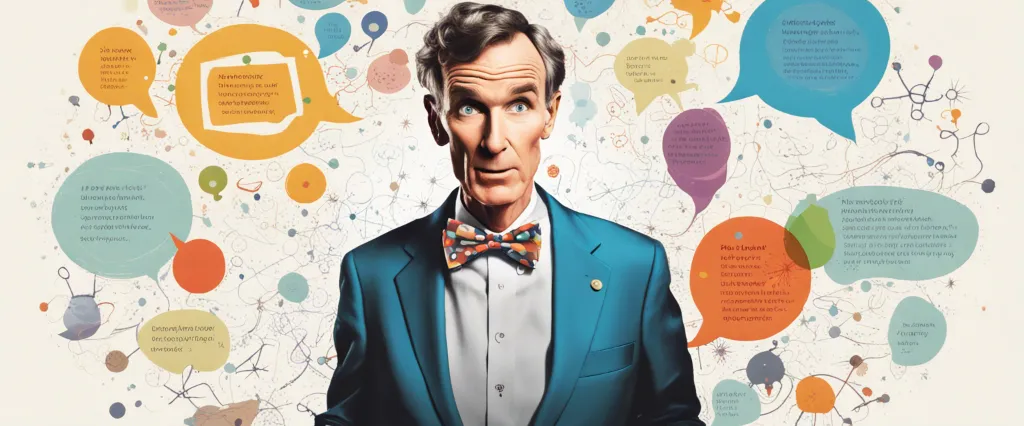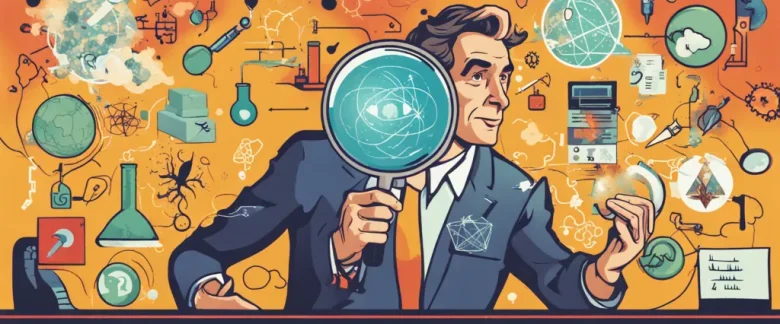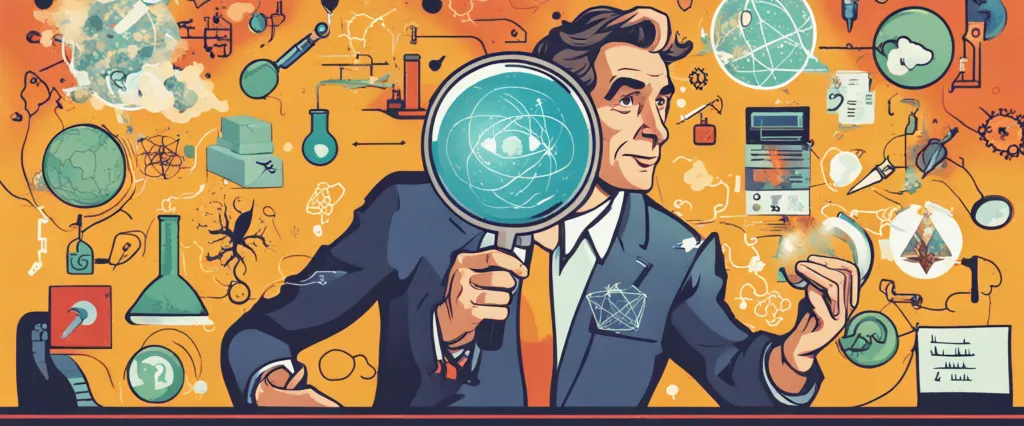In “Unstoppable” by Bill Nye, the celebrated science educator and beloved TV personality, the urgent need for action on climate change is explored. With his trademark enthusiasm and scientific expertise, Nye offers a compelling argument for taking immediate steps to mitigate the effects of global warming. As a passionate advocate for science education, Nye’s extensive background in engineering, television hosting, and communication make him a formidable voice in the fight against climate change. In “Unstoppable,” Nye presents an inspiring call to action, backed by evidence-based solutions that can help create a more sustainable future for generations to come.
Chapter 1: The Power of Science
Chapter 1: The Power of Science in the book Unstoppable by Bill Nye explores the fundamental importance of scientific thinking in solving global challenges. Nye, a renowned scientist and television personality, presents a compelling argument for embracing science as a means to tackle complex issues such as climate change, overpopulation, and inequality.
Nye begins by highlighting humanity’s remarkable progress achieved through scientific advancements over the centuries. From the Enlightenment era to the modern age, he emphasizes the power of observation, experimentation, and critical thinking in driving innovation and improving our understanding of the world.
The chapter addresses the urgent need to confront climate change, asserting that science provides the tools necessary to combat this existential threat. Nye discusses the overwhelming scientific consensus on climate change, dispelling misconceptions and highlighting the consequences of inaction. He emphasizes the importance of public engagement and political will, urging readers to trust scientific evidence and challenge climate change-denying rhetoric.
Furthermore, Nye explores interconnected issues such as overpopulation and the resulting strain on resources and ecosystems. He discusses the role of education in empowering individuals and fostering sustainable solutions. Nye argues that resolving these daunting challenges requires a collaborative effort, encouraging readers to embrace innovative ideas and push for systemic change.
In sum, Chapter 1 of Unstoppable highlights the incredible potential of science to address global problems and advocates for increased public understanding and support of scientific endeavors. Bill Nye’s enthusiasm and passion for the power of science shine through, motivating readers to embrace scientific thinking and work towards creating a more sustainable and equitable future.
Chapter 2: Exploring the Natural World
Chapter 2 of “Unstoppable” by Bill Nye, titled “Exploring the Natural World,” delves into the importance of scientific exploration and discovery in understanding the world around us. Nye starts by emphasizing the significance of curiosity and the joy of exploration, encouraging readers to question and investigate the natural world.
He highlights the vital role that scientists play in unravelling the mysteries of our planet and the cosmos, mentioning influential figures such as Galileo Galilei and Neil Armstrong. Nye illustrates the transformative power of scientific exploration by recounting his visits to iconic locations such as Galileo’s home and the Kennedy Space Center, where he witnessed the moon landing.
The chapter emphasizes the importance of using evidence-based reasoning instead of unsupported claims or personal beliefs. Nye shares his experiences of debunking pseudoscientific claims, such as anti-vaccine arguments, and highlights the need to base our conclusions on reliable evidence and scientific consensus.
Moreover, Nye discusses the significance of scientific literacy in addressing contemporary challenges. He explores topics like climate change, evolutionary biology, and genetically modified organisms, providing accessible explanations backed by scientific data. Nye argues that understanding these complex issues is crucial in making informed decisions and promoting sustainability and progress.
In conclusion, Chapter 2 of “Unstoppable” celebrates the curiosity and wonder associated with exploring the natural world and emphasizes the critical role of scientific exploration in advancing human knowledge. By championing evidence-based reasoning and promoting scientific literacy, Nye encourages readers to be active participants in the scientific discovery process and highlights the importance of science in shaping our present and future.
Chapter 3: Understanding the Scientific Method
Chapter 3 of “Unstoppable” by Bill Nye titled “Understanding the Scientific Method” delves into the fundamental principles of the scientific method and its applications in understanding our world. Nye begins by emphasizing the importance of curiosity and skepticism, highlighting how these traits are essential in driving scientific inquiry.
The chapter explores the concept of scientific literacy, emphasizing the need for the general public to understand how scientific discoveries are made. Nye argues that while the scientific method may seem complicated, it is essentially a structured and logical approach to investigating the natural world.
He breaks down the scientific method into a series of steps, starting with making observations about a particular phenomenon. Nye stresses that these observations must be unbiased and as objective as possible. From there, hypotheses are formed, which are educated guesses about how or why the observed phenomenon occurs.
Once a hypothesis is established, it must be tested through experiments. Nye explains the importance of designing controlled experiments that isolate variables to ensure accurate results. Through these experiments, scientists gather data, which is then analyzed to draw conclusions about the hypothesis.
Nye also elaborates on the significance of peer review, where other scientists review and critique research before it is published. This process ensures that scientific findings are reliable and valid. The chapter concludes with a discussion on the limitations of scientific research, acknowledging that scientific knowledge is constantly evolving as new evidence emerges.
Overall, Chapter 3 of “Unstoppable” provides a comprehensive overview of the scientific method, emphasizing its importance in fostering critical thinking, rationality, and evidence-based decision-making in our society. By understanding and embracing the scientific method, Nye argues that individuals can become informed citizens who contribute to solving problems and making the world a better place.
Chapter 4: Challenging Superstition and Bias

Chapter 4 of “Unstoppable” by Bill Nye, titled “Challenging Superstition and Bias,” discusses the negative impact of superstition and bias on scientific progress and the importance of critical thinking.
Nye starts by highlighting how superstition has long hindered scientific advancements throughout history. He explains how beliefs held without evidence, such as astrology or witchcraft, have impeded our understanding of the natural world. Furthermore, Nye points out that bias, whether based on religion, race, or gender, has limited access to knowledge and diversity of ideas within the scientific community.
Nye emphasizes the importance of skepticism and scientific inquiry in unraveling the mysteries of the universe. He encourages readers to question everything and not rely solely on authority or personal prejudices. By fostering a culture of scientific curiosity, Nye argues that we can challenge superstition and bias and make progress towards a better future.
Moreover, Nye addresses the misconceptions that exist regarding scientific theories, particularly climate change. He provides evidence from multiple scientific studies and emphasizes the consensus among the scientific community on the reality of global warming caused by human activities. Nye emphasizes the need to reject biased narratives and base our decisions on objective facts.
In this chapter, Nye demonstrates how challenging superstition and bias is not merely an intellectual exercise but a necessity for human progress. By promoting critical thinking, evidence-based conclusions, and the rejection of myths, he calls for a society that questions and understands the world around us, leading to better decision-making and positive societal change.
Chapter 5: Protecting the Future of Earth
Chapter 5: Protecting the Future of Earth from the book “Unstoppable” by Bill Nye focuses on the urgent need to address the environmental challenges we face in order to secure a sustainable and habitable future for our planet.
Nye opens the chapter by highlighting the considerable impact human activities have had on Earth’s atmosphere. He explores the detrimental effects of greenhouse gas emissions, primarily carbon dioxide, which contribute to global warming and climate change. Nye emphasizes that we must recognize the scientific consensus and take immediate action to mitigate and adapt to these changes.
The chapter then delves into the consequences of climate change, such as rising sea levels, extreme weather events, and the endangerment of numerous species. Nye underlines the importance of adopting clean, renewable energy sources to reduce carbon emissions, such as wind and solar power. He supports his arguments with examples of successful renewable energy projects worldwide and explores the economic benefits of investing in these technologies.
Nye also highlights the vital role education plays in addressing climate change. He emphasizes the necessity of providing accurate scientific information to the public and encouraging critical thinking skills that promote environmental stewardship. Nye notes that by empowering individuals with scientific knowledge, we can drive societal change and demand action from policymakers and corporations.
In this chapter, Nye also addresses the misconception that transitioning to clean energy will harm the economy. He argues that embracing renewable technologies will not only benefit the environment but also create jobs and fuel economic growth. He cites examples from different countries where green initiatives have successfully boosted local economies.
Overall, Chapter 5 of “Unstoppable” emphasizes the need for urgent and widespread action to protect our planet’s future. By addressing climate change, transitioning to clean energy, and educating the public, Nye argues that we can work towards a sustainable future and ensure the habitability of Earth for generations to come.
Chapter 6: Innovation and Application of Technology
Chapter 6 of “Unstoppable” by Bill Nye explores the topic of innovation and application of technology in a rapidly changing world. Nye begins by emphasizing the importance of technological advancements in addressing the various challenges faced by humanity, particularly in combating climate change.
Nye highlights the significance of renewable energy sources as a crucial solution for transitioning away from fossil fuels. He discusses the innovation and progress being made in harnessing clean energy, such as solar, wind, and geothermal power. Nye emphasizes the need for continued research and development in these areas to make these technologies more accessible and efficient.
The chapter also delves into the advancements in battery technology, which play a critical role in the widespread adoption of renewable energy. Nye explains how batteries enable the storage of excess energy generated by renewable sources, making it available when demand is high or when the renewable sources are not producing energy. He highlights the importance of improving battery efficiency and affordability to create a more sustainable energy grid.
Furthermore, Nye explores the innovative approaches being taken to address the growing global issue of plastic pollution. He discusses various technological solutions, including the development of biodegradable plastics, recycling initiatives, and the reduction of single-use plastics. Nye emphasizes the urgent need for both individuals and corporations to embrace these innovative solutions and make sustainable choices to mitigate the devastating impact of plastic pollution on our environment.
In conclusion, Chapter 6 of “Unstoppable” emphasizes the critical role of innovation and application of technology in addressing climate change and other environmental challenges. Nye’s passion for finding technological solutions to these issues is palpable, as he urges readers to support and advocate for continued progress in renewable energy and the reduction of plastic waste.
Chapter 7: The Importance of Science Education
Chapter 7: The Importance of Science Education, from the book “Unstoppable” by Bill Nye, highlights the critical role of science education in encouraging scientific literacy, fostering critical thinking, and preparing future generations for challenges related to climate change and global issues.
Nye begins by emphasizing that science education is crucial in developing an informed and engaged citizenry. He argues that a scientifically literate society can make better decisions regarding public policy, healthcare, and environmental issues. Moreover, Nye believes that having a solid scientific background is essential for every citizen to participate in a democracy effectively.
The author also highlights the significance of nurturing curiosity and critical thinking skills through science education. By encouraging students to ask questions and approach problems scientifically, Nye explains, we can cultivate a generation of innovative problem solvers, capable of addressing complex problems facing our planet.
Furthermore, Nye discusses the urgency of teaching climate change in schools. He argues that understanding climate science is crucial for students to comprehend the gravity of the environmental crisis. By providing students with knowledge and tools to tackle climate change, science education can inspire the next generation to take action and advocate for sustainable solutions.
Nye emphasizes that investing in science education is an investment in our future. By equipping younger generations with scientific knowledge and skills, society can better tackle global challenges, create new technologies, and drive economic growth. He also stresses the need for teachers to receive adequate training and resources to effectively teach science, advocating for increased funding and support for science education initiatives.
In conclusion, Chapter 7 highlights the critical role of science education in developing scientific literacy, fostering critical thinking, and addressing global challenges such as climate change. Nye calls for increased emphasis on science education at all levels, emphasizing the importance of nurturing future generations’ scientific understanding and problem-solving skills.

Chapter 8: Igniting Endless Curiosity
Chapter 8, “Igniting Endless Curiosity,” from the book Unstoppable by Bill Nye emphasizes the importance of curiosity in driving innovation and progress. Nye begins by discussing how curiosity has been a driving force throughout history, leading to groundbreaking discoveries and advancements. He emphasizes that fostering curiosity is essential, especially in our rapidly evolving world.
Nye highlights the role of education in nurturing curiosity. He encourages educators to create an environment that encourages questioning, experimentation, and critical thinking. He believes that when students are allowed to investigate and ask questions, they become more engaged learners and develop a lifelong passion for learning.
The chapter also explores the importance of curiosity in science. Nye stresses that science is not fixed but constantly evolving, and it is this curiosity-driven exploration that propels scientific advancements. He shares his own experiences as a scientist and the role curiosity played in his career. Nye offers an insight into the scientific process, highlighting the significance of asking thoughtful questions, making observations, and conducting experiments.
Moreover, Nye emphasizes that curiosity is not limited to the realm of science but extends to various aspects of life. He encourages individuals to approach new experiences with curiosity, stating that it allows for personal growth and a deeper understanding of the world.
In conclusion, chapter 8 of Unstoppable by Bill Nye emphasizes the vital role of curiosity in driving progress and innovation. It advocates for fostering curiosity and critical thinking in education systems and encourages individuals to approach life with an open and inquisitive mindset. Nye believes that curiosity is the key to a brighter future filled with exploration, discovery, and lifelong learning.
After Reading
In conclusion, “Unstoppable” by Bill Nye is a thought-provoking book that highlights the urgent need for action in addressing climate change. Nye’s expertise as a science communicator shines through as he presents compelling evidence, offers clear explanations, and outlines potential solutions. By emphasizing the importance of renewable energy, sustainable practices, and a collective effort from individuals, communities, and governments, he inspires readers to become changemakers in the fight against climate change. Through his optimistic yet realistic perspective, Nye leaves readers with a sense of urgency, motivation, and hope for a better, more sustainable future.
1. Sapiens: A Brief History of Humankind” by Yuval Noah Harari – In this thought-provoking book, Harari explores the history of our species, delving into the cultural, social, and technological milestones that have shaped humanity’s development from prehistoric times to the modern era.
2. “The Hidden Life of Trees: What They Feel, How They Communicate” by Peter Wohlleben – This captivating book provides insight into the fascinating world of trees, delving into their remarkable communication methods and complex social structures. Wohlleben’s narrative presents a fresh perspective on the natural world and our place within it.
3. Astrophysics for People in a Hurry” by Neil deGrasse Tyson – Similar to Bill Nye’s ability to explain complex scientific concepts in an engaging way, Tyson does the same with astrophysics. This book provides a concise and digestible overview of the universe, making it accessible to readers with any level of scientific knowledge.
4. The Innovators: How a Group of Hackers, Geniuses, and Geeks Created the Digital Revolution” by Walter Isaacson – Isaacson delves into the history of the digital age, highlighting the innovators behind the technologies that have shaped our world. By exploring their stories and contributions, the book showcases the unstoppable nature of human curiosity and ingenuity.
5. “Lab Girl” by Hope Jahren – Offering a personal and inspiring account of a woman’s journey in the scientific field, Jahren’s memoir intertwines her experiences as a paleobiologist with insights on the natural world. This book celebrates the passion and resilience required to pursue scientific research and the unstoppable determination it takes to make groundbreaking discoveries.




